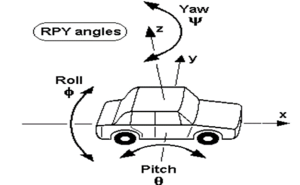Difference between revisions of "Roll-Pitch-Yaw"
From Robotics
| Line 1: | Line 1: | ||
| + | {{Navigation|before=[[Three-Angle Representations]]|overview=[[Three-Angle Representations]]|next=[[Euler angles]]}} | ||
| + | |||
| + | [[File:rpy-car.png|right|300px]] | ||
| + | |||
The roll, pitch and yaw angles are three angles defined in regard of [[Three-Angle Representations|absolute transformation]] to describe the orientation of an object, generally vehicles, in three-dimensional space. In general the three angles can be described as follows: | The roll, pitch and yaw angles are three angles defined in regard of [[Three-Angle Representations|absolute transformation]] to describe the orientation of an object, generally vehicles, in three-dimensional space. In general the three angles can be described as follows: | ||
* '''Yaw''': Rotation around the vertical axis of the object or vehicle, respectively | * '''Yaw''': Rotation around the vertical axis of the object or vehicle, respectively | ||
Revision as of 11:29, 6 May 2015
| ← Back: Three-Angle Representations | Overview: Three-Angle Representations | Next: Euler angles → |
The roll, pitch and yaw angles are three angles defined in regard of absolute transformation to describe the orientation of an object, generally vehicles, in three-dimensional space. In general the three angles can be described as follows:
- Yaw: Rotation around the vertical axis of the object or vehicle, respectively
- Pitch: Rotation around the lateral axis
- Roll: Rotation around the longitudinal axis (what is generally the movement axis of a vehicle)
There are different notations to define the axes of an object. Usually and in recent publications the vertical axis is the z-axis, the longitudal axis is x and then the lateral axis is the y-axis and directed to the left.
So the roll-pitch-yaw representation of the orientation is defined as follows:

